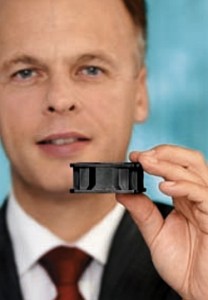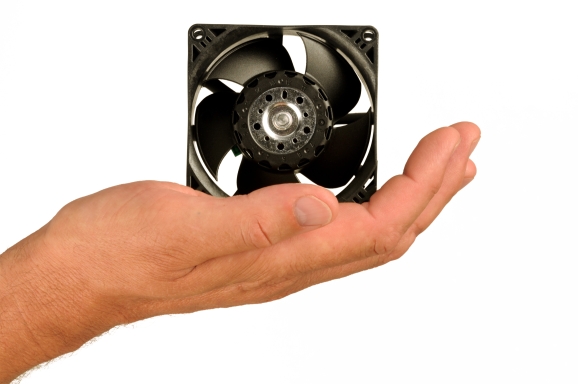It takes five milliseconds for the blade to complete one round. The tip cuts through the air at a speed of 210 kilometres per hour. The high-performance fan is called the S-Force, and it runs almost twice as fast as others its size. It uses something known as Moore’s Law. In doing so, it regains something extremely precious: installation space. At least every two years, the computing power of computer and memory chips doubles. This was predicted by Intel co-founder Gordon Moore back in 1965. Back then, chips were almost big enough to be cooled by placing one’s hand on them, mainframes filled ballrooms and the small room required for the climate control system was relatively unimportant. To this day, Moore has been proven right. Today, chip manufacturers pack the “ballrooms” into a couple of square centimetres of silicon, which, when uncooled, reaches the temperature of a hotplate at the highest setting. To prevent this, the cooling systems are becoming proportionately more complex. For example, the base station that belongs to each antenna mast in the wireless network is often no larger than the rolling drawer unit under an office desk. Inside, it is tightly packed with interchangeable IT modules. However, between ten and twenty percent of the space is reserved for the ventilation system and air circulation. The exact amount depends primarily on its maximum efficiency.
With the S-Force, ebm-papst’s engineers have followed Moore’s philosophy: pack more power into the same space. In this case, it means a massive increase in speed. This can be attained only with a special fan. The aerodynamics of a fan is tuned to a defined speed range. Anything over a certain point only causes turbulence of the air. The running power does not convert into the volumetric flow rate, and the fan “gasps”, so to speak. Moreover, the energy consumption and mechanical loads increase disproportionately. The material fatigues, the bearings overheat. A device that only rotates faster will not attain a long service life. The S-Force fan in the middle of the five speeds, however, reaches 11,000 rpm. In doing so, it pushes 570 cubic metres per hour of fresh air through its housing?— approximately the amount of air in a four-room apartment in an old building with high ceilings. Its output is three times that of a normal fan of this size, and it maintains this air flow for a good 60,000 operating hours, during which it moves 34 million cubic metres of air.

Multiplying the output in the same installation
space was the goal of Thomas Brodbek, Sales and Marketing Manager
To give the fan the necessary endurance, its creators have designed it from the beginning for maximum performance. Instead of the usual single-phase motor, it has a three-phase motor, rare earth magnets in a resin bond, a twelve-pin rather than a four-pin magnetised rotor, and a robust rotor bearing with ball bearings and special lubricants. This means a performance increase of about 500 percent compared to similar motor sizes. The motor electronics of the controllable, sensorless EC motor received new integrated circuits, which, along with all of the other measures taken, increase the motor efficiency up to 85 percent. Efficiency of 65?–?70 percent is common. The sickle-shaped blades were given “winglets” on the tips to prevent vortex generation?— which not only causes noise, it also brakes the impeller. As another safeguard against vibrations, eight fixed links, rather than the usual three reinforce the housing. These not only strengthen the design, they also lower the noise level while actually increasing the blower output. So that this marathon runner does not overheat at its fast pace, the developers also refined the air conduction through the motor. This keeps the bearing and motor at temperatures conducive to a long service life, even at full speed.Thus equipped, the example fan can run 39 billion rounds before passing on the baton. However, the owner of the telecommunications container is interested in something completely different: how much space will be gained? The answer: at the given output, approximately half the space taken up by cooling with standard fans. With the given space, what is gained is the assurance of being able to last through the next Moore cycle, when even hotter chips move in.

Leave a comment